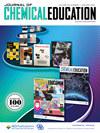KBr和Oxone在水溶液中的亲电芳香溴化反应
IF 2.9
3区 教育学
Q2 CHEMISTRY, MULTIDISCIPLINARY
引用次数: 0
摘要
亲电芳香溴化反应是一类重要的化学转化,用于合成关键中间体和产物。我们报道了一种在室温下40分钟内用KBr和Oxone在水中溴化4-甲基甲醚的实验程序。这个过程结合了绿色化学的几个原则,为芳香化合物的溴化提供了一种更安全的替代方法。用IR和1H NMR对粗反应产物进行了表征。本文章由计算机程序翻译,如有差异,请以英文原文为准。

Aqueous Electrophilic Aromatic Bromination using KBr and Oxone
Electrophilic aromatic bromination reactions are an important class of chemical transformations used to synthesize key intermediates and products. We report an experimental procedure for the bromination of 4-methylanisole using KBr and Oxone in water that can be completed in 40 min at room temperature. This procedure incorporates several principles of green chemistry, providing a safer alternative to the traditional method used for bromination of aromatic compounds. The crude reaction product was characterized using IR and 1H NMR.
求助全文
通过发布文献求助,成功后即可免费获取论文全文。
去求助
来源期刊

Journal of Chemical Education
化学-化学综合
CiteScore
5.60
自引率
50.00%
发文量
465
审稿时长
6.5 months
期刊介绍:
The Journal of Chemical Education is the official journal of the Division of Chemical Education of the American Chemical Society, co-published with the American Chemical Society Publications Division. Launched in 1924, the Journal of Chemical Education is the world’s premier chemical education journal. The Journal publishes peer-reviewed articles and related information as a resource to those in the field of chemical education and to those institutions that serve them. JCE typically addresses chemical content, activities, laboratory experiments, instructional methods, and pedagogies. The Journal serves as a means of communication among people across the world who are interested in the teaching and learning of chemistry. This includes instructors of chemistry from middle school through graduate school, professional staff who support these teaching activities, as well as some scientists in commerce, industry, and government.
 求助内容:
求助内容: 应助结果提醒方式:
应助结果提醒方式:


